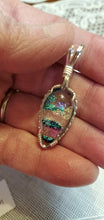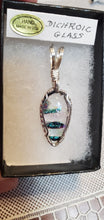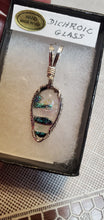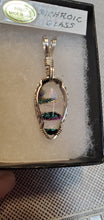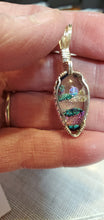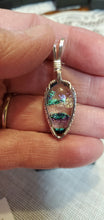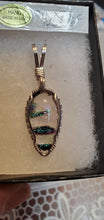
Custom Wire Wrapped Dichroic Glass Necklace/Pendant.slide/Enhancer Sterling Silver .935 size: 1 11/16 x 9/16 inch or 42mm x 14mm One of a kind cabochon and will pick up the colors that you are wearing. Beautiful colorings.
What is dichroic? The word Dichroic comes from the two Greek roots “di” meaning two and “chroma” meaning color. Therefore it means “two colors” – two primary colors. One-color is reflected and one is transmitted. However, each piece of this specialty glass has many secondary colors. As the piece of art glass is turned, the light will begin to bring out a rainbow of colors. Because of its beauty, it is very popular in fused glass projects and in jewelry making.
In order to truly give the meaning of "dichroic" in today's world, we know that it means far more than just "two colors". It includes the unique process of depositing the metallic coating on thin sheets of glass. In order to explain that process, it helps to know some of the histories.
History of Dichroic
There are people who date dichroic glass to the years before Christ. That depends on what you think "dichroic" means. We have had beautiful fused and blown glass for many centuries. However, the technique that gives us the dichroic glass of today is very complex and has only been used in the past few decades. We have heard two stories about the recent history of “dichroic glass”. Some say that NASA was conducting experiments to find the “perfect” materials for the space helmet reflector, and others say the experiments were for the satellite mirrors. People do agree that it all began with NASA experiments. From what we understand, NASA placed various materials in a vacuum chamber and injected a fine mist of metal oxides inside. This deposited very thin layers of the metal onto the objects. I have simplified the actual steps involved in the process, but the results were incredible.
These experiments have resulted in many applications for metallic coating. It is used in film-producing equipment, sunglasses, infrared lasers, and fiber optics. When the glass companies saw the results of these experiments, they began to use similar techniques to make this new kind of art glass. They make this unique glass by depositing several layers of metal oxides, such as magnesium, titanium, and silicon, onto the glass through a very highly technical process in a vacuum furnace set at a very high







